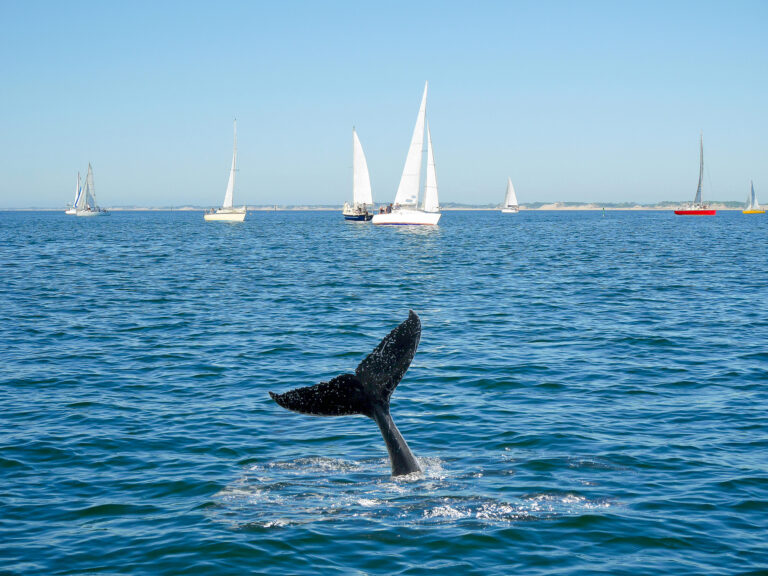
The answer to the question “How long does a sail last?” is pretty complicated. You need to consider two factors: structural integrity and shape life. As a triangle, sails will last for a surprisingly long time. Structurally, though, sails gradually lose their integrity as the materials and stitching fail under the influence of the sun and use. Sails that stretch too much are unable to retain a critical airfoil shape (having a distinct rounded entry and flat, straight exit). Here’s a look at each of these factors.
Structural Integrity
UV causes woven polyester materials (Dacron®) to gradually lose tear strength. If you can take an existing tear and easily extend it by pulling with moderate pressure, it’s over. You can fix the tear with a patch, but it will keep tearing in other places, often at the edge of any repair. Likewise, if you can run your fingernail across the stitching and pick it off easily, the sail needs re-stitching. It’s normal for the stitching to rot before the material in the sail; that’s why it is important to examine sail stitching periodically and re-stitch areas as needed.
How long this degradation process takes is influenced sunlight exposure and UV strength. Other factors include the amount of breeze they regularly fly in, flogging, chafe, and other abuse they receive. Ultimately, a better way to think of the structural life of your sails is in terms of hours of use: a reasonably well-treated woven polyester sail that is maintained regularly will last 3500-4000 hours.
A typical weekend cruising sailor who sails his boat two weekends a month, plus two weeks of cruising during a five-month season will accumulate roughly 240 hours per year. Those sails will last for 16 years! At the other extreme, a person living aboard their boat and cruising the Caribbean extensively will use their sails as many as 12 hours per day, 12 days per month, 12 months a year for an average of 1,728 hours a year. This sailor will need to replace sails every 2.5 years. Do the math for your type of sailing and you’ll get an idea as to how long your sails will last.
Shape Life
The shape life of a sail is more difficult to assess, since sail shape deteriorates gradually with every hour of use. Its affect on performance is much harder to judge than the physical condition of the cloth, but there are some symptoms to look for. Sails that stretch too much become too full, and are unable to retain a critical airfoil shape. This loss can impact your racing performance.
Even if you’re a cruising sailor who’s not concerned with performance, sail shape is critical to control heel. Full, stretchy sails rob power in light air, but – more critically – they create heel and weather helm when you want control. At some point, you have to sail upwind, usually at the least convenient times. One of the real luxuries and pleasures of a good cruising boat is the ability to sail effectively upwind when necessary. If your sails don’t have proper shape, the boat will not be able to go upwind effectively.
Unfortunately, shape life degrades more rapidly than structural life. It depends on harshness of use, but even when treated well, sails can only be expected to retain good shape for half to two-thirds of the structural life of a sail – that’s roughly 1,700 to 2,700 hours of use. How much deterioration in sail shape you are willing to accept is a subjective matter. Periodic re-cutting helps. If the material is in decent condition, excess shape can be removed and an effective airfoil shape restored.
Preserving Your Sail’s Life
Relative to much of the gear on your boat, sails do last a long time, but not forever. When you do decide to replace them, your boat will come alive as dramatically as if you had put a new engine in your car. You’ll gain a greater sense of control, and going to weather might be fun again (at least for short periods of time).
To help protect your sail investment, here are some suggestions:
• Protect your sails from unnecessary exposure to sunlight and heat.
• Avoid prolonged luffing and flogging.
• Motor with your sails down unless they can be filled.
• Never back a genoa against the spreaders when tacking.
• Use the correct halyard tension: halyard tension changes as a function of apparent wind velocity. Add just enough tension to remove horizontal wrinkles as the apparent wind increases. Ease when the apparent wind velocity drops.
• Protect from chafe: make sure spreader and chafe patches are in the right place.
• Take sails off the boat when not in use or out of the water for any extended time period.
• Periodically rinse with fresh water (annual professional servicing and washing is recommended).
• Store sails dry. Be sure roller furling sails are well secured when leaving the boat.
This cruising tip has been brought to you by Quantum Sails.








